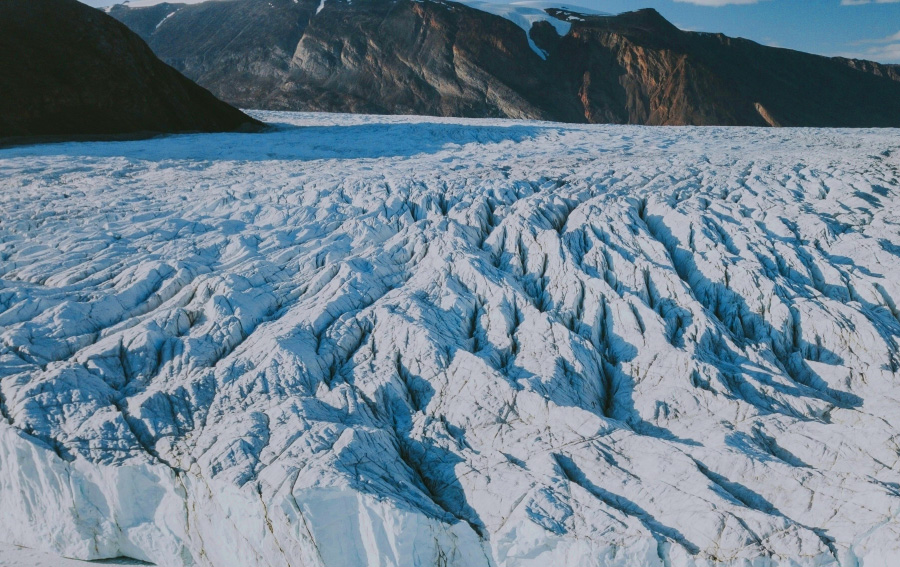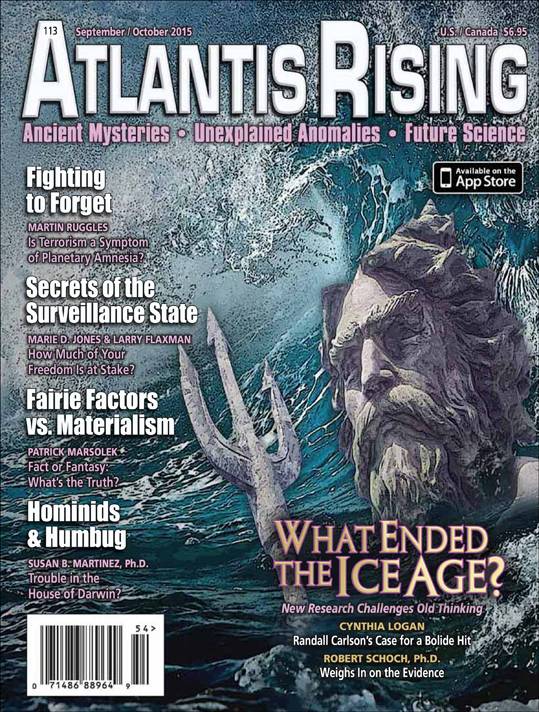
SIDEBAR: John Anthony West has complained that Ph.D. candidates in Egyptology spend way too much time on subjects like Tutankhamun’s…
You must be logged in to view this content.

SIDEBAR: John Anthony West has complained that Ph.D. candidates in Egyptology spend way too much time on subjects like Tutankhamun’s…
You must be logged in to view this content.

A new study that reconstructs the history of sea level at the Bering Strait shows that the Bering Land Bridge connecting Asia to North America did not emerge until around 35,700 years ago, less than 10,000 years before the height of the last ice age (known as the Last Glacial Maximum).
The new findings, published in Proceedings of the National Academy of Sciences, indicate that the growth of the ice sheets—and the resulting drop in sea level—occurred surprisingly quickly and much later in the glacial cycle than previous studies had suggested (https://www.pnas.org/doi/10.1073/pnas.2206742119).
“It means that more than 50 percent of the global ice volume at the Last Glacial Maximum grew after 46,000 years ago,” said Tamara Pico, assistant professor of Earth and planetary sciences at UC Santa Cruz and a corresponding author of the paper. “This is important for understanding the feedbacks between climate and ice sheets, because it implies that there was a substantial delay in the development of ice sheets after global temperatures dropped.”
Global sea levels drop during ice ages as more and more of Earth’s water gets locked up in massive ice sheets, but the timing of these processes has been hard to pin down. During the Last Glacial Maximum, which lasted from about 26,500 to 19,000 years ago, ice sheets covered large areas of North America. Dramatically lower sea levels uncovered a vast land area known as Beringia that extended from Siberia to Alaska and supported herds of horses, mammoths, and other Pleistocene fauna. As the ice sheets melted, the Bering Strait became flooded again around 13,000 to 11,000 years ago.
The new findings are interesting in relation to human migration because they shorten the time between the opening of the land bridge and the arrival of humans in the Americas. The timing of human migration into North America remains unresolved, but some studies suggest people may have lived in Beringia throughout the height of the ice age.
“People may have started going across as soon as the land bridge formed,” Pico said.
The new study used an analysis of nitrogen isotopes in seafloor sediments to determine when the Bering Strait was flooded during the past 46,000 years, allowing Pacific Ocean water to flow into the Arctic Ocean. First author Jesse Farmer at Princeton University led the isotope analysis, measuring nitrogen isotope ratios in the remains of marine plankton preserved in sediment cores collected from the seafloor at three locations in the western Arctic Ocean. Because of differences in the nitrogen composition of Pacific and Arctic waters, Farmer was able to identify a nitrogen isotope signature indicating when Pacific water flowed into the Arctic.
The findings imply a complicated relationship between climate and global ice volume and suggest new avenues for investigating the mechanisms underlying glacial cycles.
Pictures and Captions
https://news.ucsc.edu/2022/12/bering-strait.html


The Thwaites Glacier in West Antarctica—about the size of Florida—has been an elephant in the room for scientists trying to make global sea level rise predictions. This massive ice stream is already in a phase of fast retreat (a “collapse” when viewed on geological timescales) leading to widespread concern about exactly how much, or how fast, it may give up its ice to the ocean. The potential impact of Thwaites’ retreat is spine-chilling: a total loss of the glacier and surrounding icy basins could raise sea level from three to ten feet.
A new study in Nature Geoscience led by marine geophysicist Alastair Graham at the University of South Florida’s College of Marine Science (USF CMS), adds cause for concern.
For the first time, scientists mapped in high-resolution a critical area of the seafloor in front of the glacier that gives them a window into how fast Thwaites retreated and moved in the past.
The team documented more than 160 parallel ridges that were created, like a footprint, as the glacier’s leading edge retreated and bobbed up and down with the daily tides. “It’s as if you are looking at a tide gauge on the seafloor,” said Graham. “It really blows my mind how beautiful the data are.”
Beauty aside, what’s alarming is that the rate of Thwaites’ retreat that scientists have documented more recently are small compared to the fastest rates of change in its past, said Graham.
To understand Thwaites’ past retreat, the team analyzed the rib-like formations submerged 700 meters (just under half a mile) beneath the polar ocean and factored in the tidal cycle for the region, as predicted by computer models, to show that one rib must have been formed every single day.
At some point in the last 200 years, over a duration of less than six months, the front of glacier lost contact with a seabed ridge and retreated at a rate of more than 2.1 kilometers per year (1.3 miles per year) — twice the rate documented using satellites between 2011 and 2019.
“Our results suggest that pulses of very rapid retreat have occurred at Thwaites Glacier in the last two centuries, and possibly as recently as the mid-20th Century,” said Graham.
“Thwaites is really holding on today by its fingernails, and we should expect to see big changes over small timescales in the future – even from one year to the next – once the glacier retreats beyond a shallow ridge in its bed,” said marine geophysicist and study co-author, Robert Larter, from the British Antarctic Survey.
To collect the imagery and supporting geophysical data, the team, which included scientists from the United States, the United Kingdom, and Sweden, launched a state-of-the-art orange robotic vehicle loaded with imaging sensors called ‘Rán’ from the R/V Nathaniel B. Palmer during an expedition in 2019. Rán, operated by scientists at the University of Gothenburg in Sweden, embarked on a 20-hour mission that was as risky as it was serendipitous, Graham said. It mapped an area of the seabed in front of the glacier about the size of Houston – and did so in extreme conditions during an unusual summer notable for its lack of sea ice. This allowed scientists to access the glacier front for the first time in history.


By Bill Hathaway
New research has provided the strongest evidence yet that Earth’s continents were formed by giant meteorite impacts that were particularly prevalent during the first billion years or so of our planet’s four-and-a-half-billion year history.
Dr Tim Johnson, from Australia’s Curtin University School of Earth and Planetary Sciences, said the idea that the continents originally formed at sites of giant meteorite impacts had been around for decades, but until now there was little solid evidence to support the theory.
“By examining tiny crystals of the mineral zircon in rocks from the Pilbara Craton in Western Australia, which represents Earth’s best-preserved remnant of ancient crust, we found evidence of these giant meteorite impacts,” Dr Johnson said.
“Studying the composition of oxygen isotopes in these zircon crystals revealed a ‘top-down’ process starting with the melting of rocks near the surface and progressing deeper, consistent with the geological effect of giant meteorite impacts.
“Our research provides the first solid evidence that the processes that ultimately formed the continents began with giant meteorite impacts, similar to those responsible for the extinction of the dinosaurs, but which occurred billions of years earlier.”
Dr Johnson said understanding the formation and ongoing evolution of the Earth’s continents was crucial given that these landmasses host the majority of Earth’s biomass, all humans and almost all of the planet’s important mineral deposits.
“Not least, the continents host critical metals such as lithium, tin and nickel, commodities that are essential to the emerging green technologies needed to fulfil our obligation to mitigate climate change,” Dr Johnson said.
“These mineral deposits are the end result of a process known as crustal differentiation, which began with the formation of the earliest landmasses, of which the Pilbara Craton is just one of many.
“Data related to other areas of ancient continental crust on Earth appears to show patterns similar to those recognized in Western Australia. We would like to test our findings on these ancient rocks to see if, as we suspect, our model is more widely applicable.”
Dr Johnson is affiliated with The Institute for Geoscience Research (TIGeR), Curtin’s flagship earth sciences research institute.
The paper, ‘Giant impacts and the origin and evolution of continents’, was published in Nature and is available online here: https://www.nature.com/articles/s41586-022-04956-y


By Daniel Stolte
Where did the ice sheets that rang in the last ice age more than 100,000 years ago come from, and how could they grow so quickly? A new study tries to solved both mysteries.
Understanding what drives Earth’s glacial–interglacial cycles—the periodic advance and retreat of ice sheets in the Northern Hemisphere—is no easy feat, and researchers have devoted substantial effort to explaining the expansion and shrinking of large ice masses over thousands of years. The new study from University of Arizona researchers, published in the journal Nature Geoscience, proposes an explanation for the rapid expansion of the ice sheets that covered much of the Northern Hemisphere during the most recent ice age, and the findings could also apply to other glacial periods throughout Earth’s history.
About 100,000 years ago, when mammoths roamed the Earth, the Northern Hemisphere climate plummeted into a deep freeze that allowed massive ice sheets to form. Over a period of about 10,000 years, local mountain glaciers grew and formed large ice sheets covering much of today’s Canada, Siberia and northern Europe.
While it has been widely accepted that periodic “wobbling” in the Earth’s orbit around the sun triggered cooling in the Northern Hemisphere summer that caused the onset of widespread glaciation, scientists have struggled to explain the extensive ice sheets covering much of Scandinavia and northern Europe, where temperatures are much more mild.
Unlike the cold Canadian Arctic Archipelago where ice readily forms, Scandinavia should have remained largely ice-free due to the North Atlantic Current, which brings warm water to the coasts of northwestern Europe. Although the two regions are located along similar latitudes, the Scandinavian summer temperatures are well above freezing, while the temperatures in large parts of the Canadian Arctic remain below freezing through the summer, according to the researchers. Because of this discrepancy, climate models have struggled to account for the extensive glaciers that advanced in northern Europe and marked the beginning of the last ice age, said the study’s lead author, Marcus Lofverstrom.
“The problem is we don’t know where those ice sheets (in Scandinavia) came from and what caused them to expand in such a short amount of time,” said Lofverstrom, an assistant professor of geosciences and head of the UArizona Earth System Dynamics Lab.
To find answers, Lofverstrom helped develop an extremely complex Earth-system model, known as the Community Earth System Model, which allowed his team to realistically recreate the conditions that existed at the beginning of the most recent glacial period. Notably, he expanded the ice-sheet model domain from Greenland to encompass most of the Northern Hemisphere at high spatial detail. Using this updated model configuration, the researchers identified the ocean gateways in the Canadian Arctic Archipelago as a critical linchpin controlling the North Atlantic climate and ultimately determining whether or not ice sheets could grow in Scandinavia.
The simulations revealed that as long as the ocean gateways in the Canadian Arctic Archipelago remain open, Earth’s orbital configuration cooled the Northern Hemisphere sufficiently to allow ice sheets to build up in Northern Canada and Siberia, but not in Scandinavia.
In a second experiment, the researchers simulated a previously unexplored scenario in which marine ice sheets obstructed the waterways in the Canadian Arctic Archipelago. In that experiment, the comparatively fresh Arctic and North Pacific water – typically routed through the Canadian Arctic Archipelago – was diverted east of Greenland, where deep water masses typically form. This diversion led to a freshening and weakening of the North Atlantic deep circulation, sea ice expansion, and cooler conditions in Scandinavia.
“Using both climate model simulations and marine sediment analysis, we show that ice forming in northern Canada can obstruct ocean gateways and divert water transport from the Arctic into the North Atlantic,” Lofverstrom said, “and that in turn leads to a weakened ocean circulation and cold conditions off the coast of Scandinavia, which is sufficient to start growing ice in that region.”
“These findings are supported by marine sediment records from the North Atlantic, which show evidence of glaciers in northern Canada several thousand years before the European side,” said Diane Thompson, assistant professor in the UArizona Department of Geosciences. “The sediment records also show compelling evidence of a weakened deep ocean circulation before the glaciers form in Scandinavia, similar to our modeling results.”
Together, the experiments suggest that the formation of marine ice in northern Canada may be a necessary precursor to glaciation in Scandinavia, the authors write.
Pushing climate models beyond their traditional application of predicting future climates provides an opportunity to identify previously unknown interactions in the Earth system, such as the complex and sometimes counterintuitive interplay between ice sheets and climate, Lofverstrom said.
“It is possible that the mechanisms we identified here apply to every glacial period, not just the most recent one,” he said. “It may even help explain more short-lived cold periods such as the Younger Dryas cold reversal (12,900 to 11,700 years ago) that punctuated the general warming at the end of the last ice age.”



Age may be just a number, but it’s a number that often carries unwanted side effects, from brittle bones and weaker muscles to increased risks of cardiovascular disease and cancer. Now, scientists at the Salk Institute, in collaboration with Genentech, a member of the Roche group, have shown that they can safely and effectively reverse the aging process in middle-aged and elderly mice by partially resetting their cells to more youthful states.
As organisms age, it is not just their outward appearances and health that change; every cell in their bodies carries a molecular clock that records the passage of time. Cells isolated from older people or animals have different patterns of chemicals along their DNA—called epigenetic markers—compared to younger people or animals. Scientists know that adding a mixture of four reprogramming molecules—Oct4, Sox2, Klf4 and cMyc, also known as “Yamanaka factors”—to cells can reset these epigenetic marks to their original patterns. This approach is how researchers can dial back adult cells, developmentally speaking, into stem cells.
In 2016, Izpisua Belmonte’s lab reported for the first time that they could use the Yamanaka factors to counter the signs of aging and increase life span in mice with a premature aging disease. More recently, the team found that, even in young mice, the Yamanaka factors can accelerate muscle regeneration. Following these initial observations, other scientists have used the same approach to improve the function of other tissues like the heart, brain and optic nerve, which is involved in vision.
In the new study, Izpisua Belmonte and his colleagues tested variations of the cellular rejuvenation approach in healthy animals as they aged. One group of mice received regular doses of the Yamanaka factors from the time they were 15 months old until 22 months, approximately equivalent to age 50 through 70 in humans. Another group was treated from 12 through 22 months, approximately age 35 to 70 in humans. And a third group was treated for just one month at age 25 months, similar to age 80 in humans.
“What we really wanted to establish was that using this approach for a longer time span is safe,” says Pradeep Reddy, a Salk staff scientist and co-first author of the new paper. “Indeed, we did not see any negative effects on the health, behavior or body weight of these animals.”
Compared to control animals, there were no blood cell alterations or neurological changes in the mice that had received the Yamanaka factors. Moreover, the team found no cancers in any of the groups of animals.




Scientists think they have learned just how fast ice in Antartica retreated at the end of the last ice age about 12,000 years ago, but the numbers are not what they expected. A study of seafloor ridges published in May of 2020 in the journal Science shows an astonishing retreat rate of about 50 miles a day, roughly ten times as fast as anything observed by satellites today. For scientists arguing that melting Ice in Antarctica is the harbinger of an approaching disastrous sea rise, this could be a problem, but it is not the only one.
Professor Julian Dowdeswell, director of the Scott Polar Research Institute (SPRI) in Cambridge, UK, led an expedition last year to the Larsen region of the Antarctic Peninsula. Using autonomous underwater vehicles with high resolution mapping capability, the team studied sediments at the bottom of the western Weddell Sea. In a manner somewhat analogous to tree rings, the ridges formed by seasonal changes in regular tidal patterns, it was theorized, could provide a virtual time line to measure the ice’s rate of retreat as temperatures warmed up. (https://science.sciencemag.org/content/368/6494/1020). Unexpectedly, the study casts new doubt on one of the basic assumptions of modern science: uniformitarianism.
In the seventeenth and eighteenth centuries in Europe, when science in the modern sense was first emerging, those who investigated rocks, landforms, and fossils—in studies that would evolve into geology and paleontology—believed Earth’s past had been shaped by sudden and violent catastrophes, chief among them: Noah’s Flood. These scientists were strongly influenced by the Bible, but as Christianity fell into disfavor among many intellectual elites, ‘catastrophism’ came to be rejected in favor of ‘uniformitarianism’, the belief that the past was shaped by the same processes we can observe today—slow climatic change, the gradual advance and retreat of glaciers, the almost imperceptible rise of mountain ranges, and the equally slow process of erosion, leveling those ranges and carving out valleys. By the late eighteenth century, the proponents of uniformitarianism, chiefly James Hutton and Charles Lyell, dominated the earth sciences. There was a brief rebellion in the early nineteenth century, led by Georges Cuvier, who, although he did not rely on any Biblical accounts, believed that there had been truly catastrophic floods and earthquakes in the past. But his rebellion failed, and uniformitarianism became a dogma, not to be questioned. (“Catastrophism Reconsidered,” William B. Stoecker, Atlantis Rising Magazine, #111, May/June, 2016)
The new Antarctic sea floor study also creates a problem for the study of climate change. Researcher Randall Carlson who has studied the Missoula Flood, and other giant floods accompanying the end of the last ice age made the point in a 1997 lecture at Warren Wilson College in North Carolina. “Whether we look at it from year to year, over decades or through the centuries, we find that at whatever scale we use, the climate has been vastly changing. When you have six to seven million cubic miles of ice melt over a few thousand years, it’s reasonable to conclude that the sole driver of climate change is not carbon.” (“What Ended the Ice Age?,” Cynthia Logan, Atlantis Rising Magazine, #113, September/October, 2015).
Below are articles from our back issues that connect very directly to this content.
Available for purchase and download.
 Issue #111
Issue #111
 from the Member’s Archive
from the Member’s Archive![]()

Thousands of years before the time of Jesus, artisans north of the Mediterranean perfected a metal alloy made from a combination of copper and tin called bronze. From 3000 to 1200 BC, the Bronze Age would give rise, not only to many marvelous artifacts, as well as writing, and much of what we now call civilization, but, until recently, it has not been entirely clear where all the copper and tin came from. Copper, it has been thought, came from various European mines, though there is evidence pointing to sources in North America. As for tin: the source has been a long-standing mystery. Conventional research has pointed to somewhere in Central Asia, but a new study threatens to change that.
Bronze age tin ingots from a thousand years BC found off the coast of Israel have been shown to be from Cornwall and Devon in Britain. Isotopic data was analyzed by German researchers at Heidelberg University, and the Curt Engelhorn Center for Archaeometry in Mannheim. Other ingots found in Greece and Turkey were also determined to be from Cornwall. The study was done by Dr. Ernst Pernicka and colleagues. The main takeaway: international trading routes 3000 years ago were much more advanced than is generally believed. (https://www.archaeology-world.com/scientists-find-that-tin-found-in-israel-from-3000-years-ago-comes-from-cornwall/)
Naming Cornwall as the source of middle eastern tin, corroborates at least one alternative narrative relating to Jesus. Joseph of Arimathea, identified in the New Testament as the donor of Jesus’ tomb, was also said in church tradition to be a wealthy tin merchant. According to apocryphal sources, Joseph traveled to Cornwall with the teenage Jesus, and returned after the crucifixion to bring the ‘Holy Grail’ and Christianity to Britain.
Below are articles from our back issues that connect very directly to this content.
Available for purchase and download.
 Issue #134
Issue #134
 From the Member’s Archive
From the Member’s Archive![]()

In This 88-page edition: